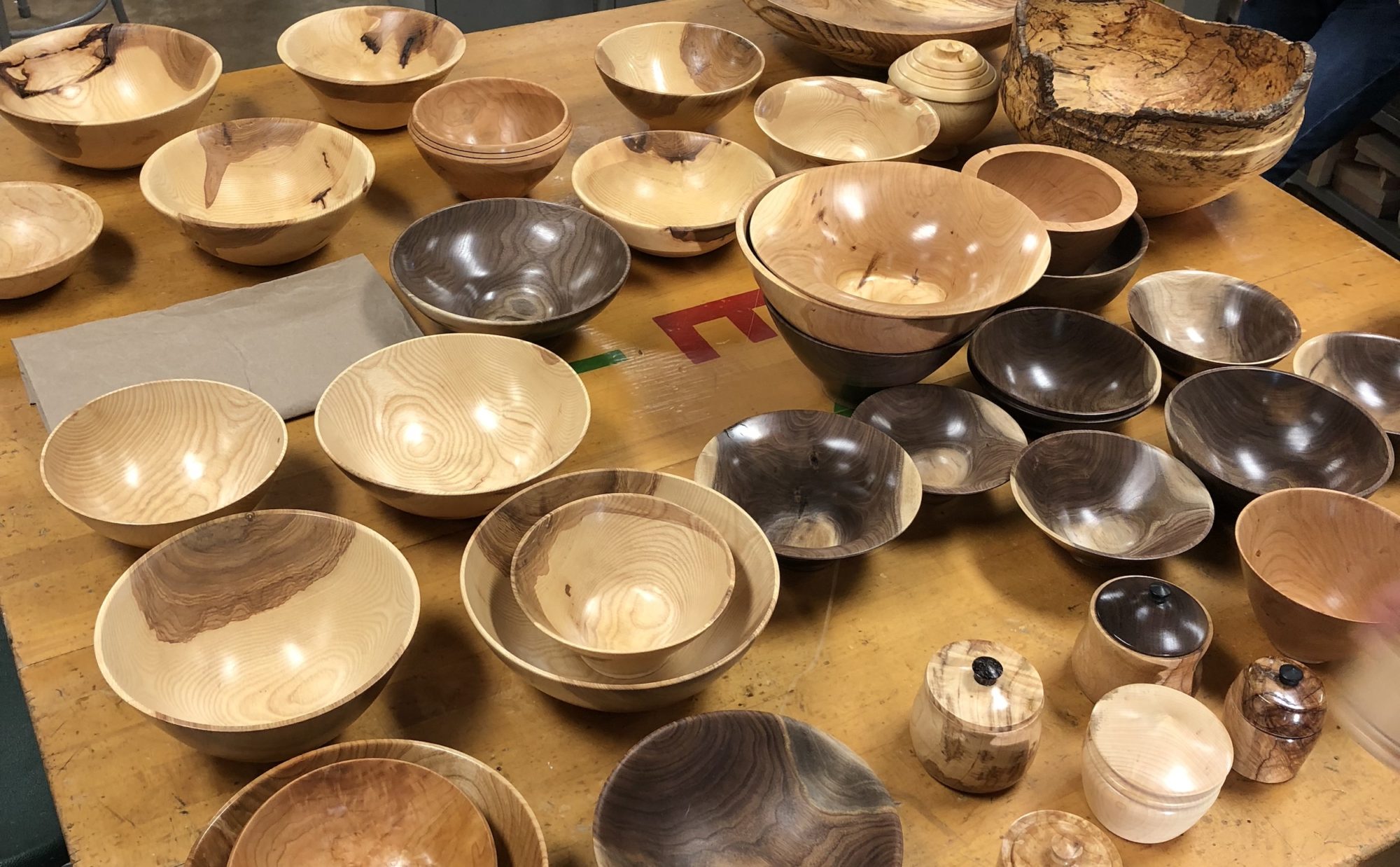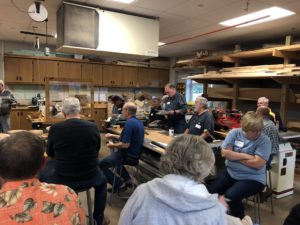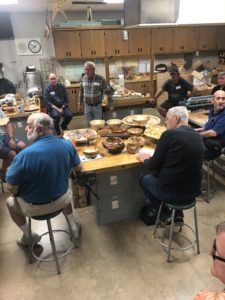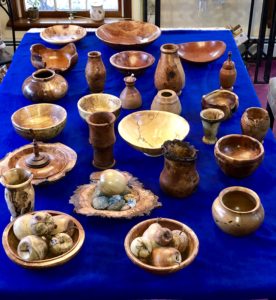In October Dave Lutzkanin from Windy Hill WoodTurning shared all kinds of information and tips for selling products at craft fairs. There are many things to consider and if you are interested you’ll find this information invaluable.
www.windyhillwoodturning.com
So, you want to do craft shows?
This article is based on a presentation Dave gave as a demonstrator at the Totally Turning Symposium in Saratoga, NY in March 2019. The following is provided as a guide of information for consideration prior to your first show.
Like many other craftsmen, the plethora of objects collected by our turning hobby soon outgrows the gift giving of friends and relatives. Encouraged by those people who have received gifts, we think about making money from our hobby and new found skills. Beware! This may soon turn into a job! If you are just hoping for a few sales to buy more tools and materials, then I suggest you stick to selling online with Facebook, Etsy, etc. For some of us, we view our hobby as a money making venture. Enter the craft show! Allow me to say this now; if you are planning to do shows on a regular basis, you will need to make a considerable investment of both time and money. It has been said in the business world, that you can’t make money without spending money first, and that certainly holds true here. There are many investments and expenditures that you will encounter. My goal with this article is to help you begin.
My fiance’, Elaine Nichols and I did our first show in 2012. Our booth from that first show is figure #1. Our venture has come along way since then! Our booth, displays, products, thinking and skills have been transformed during this journey. I hope to provide you with plenty of food for thought with this article.
So, you want to do craft shows? What’s next? Let’s begin…..
Locating shows
First, you need to find a show.
–Talk to vendors at shows. The most knowledgeable people are the full timers. They dont waste time on poor shows. Also don’t be afraid to ask for advice, opinion and commentary from these artisans.
–Google is your friend here. There are various services and sites that will email you lists of shows in your region. Some are free, some ask for a fee. –Try to stick with juried shows. A juried show means your work is judged by a jury and accepted as quality enough to enter the show. Good photos are paramount here. Jurying prevents you from being next to the “popsicle stick” sort of crafts. It also prevents an overload of the same type of craft. There are exceptions however. One of our best shows annually is not juried. But we have been burned several times. It’s a gamble.
–Attend a show in person the year before whenever possible. This lets you see the show, how its run, the quality of the work, the crowd, traffic flow and any competition. Take notice of the customers. Listen to the customers. Are they carrying bags of purchases or walking around with no bags? Are they only there for the food, the music or the fireworks? Are these people your target clientele? Some shows attract a great crowd, but the sales are poor. Your top show may be another’s worst show. It’s all in the customer base. You need to know the area. Is it affluent or economically depressed?
–Be wary of shows with alcohol. Wine and craft beer festivals can draw a large crowd, but are they shopping or drinking? Again, it pays to check this type of show out in person. Obviously, intoxicated people bring their own unique set of issues. Another gamble.
Expenses to Consider Every business needs start up cash.
–Jury fees and application fees are standard. B ooth fees vary depending on size ( 10 ft by 10 ft is common) and duration of show (one day vs four day). The shows we enter, on average, cost about $100 per day plus jury fee. Most jury fees are $15-$50 and are payable up front before acceptance or rejection and are non refundable.
–Taxes. Sole proprietorship, LLC, or S Corp? Talk to your accountant. You will probably begin as a sole proprietorship. Save the receipt each and every time you reach in your wallet for a business purchase. Keep track of business mileage for your vehicle.
–Canopy. Must be strong enough to withstand severe weather. Hold it down! Stakes, weights, etc. Walls are necessary and sometimes required by the show. If you plan to make this a long term venture, then invest in quality. The canopies with steel pipe framing are worth every penny and withstand adverse weather far better than the cheap ones from a department store.
–Insurance. Doing business is risky without liability insurance in today’s litigious society. AAW members can purchase through the Hartford Group. Info on AAW website. Protect yourself.
–Inventory. And so it begins! You need to get busy making your products to sell. The largest time investment you will make is with production. Find efficient ways of making items quickly. TIME IS MONEY! I hate to break this to you, but you will spend a considerable amount of time turning objects that you don’t WANT to turn. Making items that sell is your goal. I very rarely get to turn what I WANT to turn. If you are not willing to do this, then you need to stop and reconsider your decision. Buying in bulk increases your profit margin. Purchasing wood, kits, and other materials in bulk will save you money in the long run. This point could easily be another article in itself.
–Plastic Totes Purchase plastic tote boxes from your local store. Get the type that have clamping lids and stack easy. You may need different sizes depending on your products. Learn from my experience here. It seems like a good idea to recycle those cardboard shipping boxes to transport product, until it rains! Or you pick up a cardboard box that was sitting on the ground and absorbed moisture from overnight dew. Bam! All your expensive handmade items are now on the ground! These totes go on sale frequently, shop smart.
–Assorted items. Ratchet straps, bungee cords, weights, clamps, basic tools, knife, extension cord, fan, heater, etc You will add to this list after a show or two.
Conducting Business Selling accoutrements.
–Cash box. Make sure it can be locked. Small enough to take to bathroom with you. You will invariably have to use the restroom when you are alone at a show; or you will have to return to your vehicle for an item. –Credit card reader. S quare and paypal are the major two here. They both work from a smart-phone. In 2018, 78% of our sales were from credit cards. This is typical from speaking with our vendor friends. People don’t carry cash like they used to. We use square, its free. There is a per swipe fee and an offline mode. I created a separate, business bank account for this purpose. Another tip here from our experience…don’t accept checks. Unless you’re in offline mode on your card reader, the card will tell you immediately accepted or denied. Checks bounce. Besides, most every checking account can have a debit card linked to it for card sales. –License. Sales tax license from your state or county is required for shows. This was free in our state. You also may need to register your business name. Check your locale for regulations and application procedures.
–Internet. Try to have a website where customers can see examples of your work. Email contact is a must in today’s world, most website hosting will have associated email accounts.
A facebook page for people to follow is also beneficial. Facebook is a great way to advertise upcoming shows, showcase booth pictures at shows, products being sold, and to sell a few items too!
–Sales items. You will need bags,boxes,tissue paper, etc for items sold. Business cards, banner, price tags and signs round out your professional looking booth.
Booth Set Up How are people going to see your work?
–Display. Avoid just using tables. Place your most expensive products at eye level. Use varying levels of display. What can people see from 50 yards away? What is going to draw customers into your booth? The interior is what sets your white canopy apart from the 100 other white canopies. Don’t be afraid to seasonally decorate.
–Avoid clutter. Is it too busy? Does it look like a yard sale? Does it appear to have been thrown together that morning or does it show some thought and effort? People notice these things and they base their purchase decisions accordingly.
–Your display should not overshadow the product. I saw a booth once where the shelving was absolutely stunning. Made from very expensive wood, but the product being sold was very plain. It should be the other way around. The display should showcase your work. All of our displays are painted black. Choose a neutral color and go with it.
–Weather. Can the display withstand the weather? Wind, rain, snow, ice, humidity, muddy ground, etc? Be prepared. Clamps, tarps, clothes pins, towels and rags. Rain gear for wear? Bug spray, sun screen, heater, fan. There are many things to consider here, and it depends on you and your booth.
–Shims. Take a box of shims. Ground is rarely level, even on concrete. Streets are crowned. Be careful of street gutters, they will flow with water when raining.
–Workspace. You need a place to “work.” This needs to be in your booth plan. Need cashier space and an area to package items. I have seen many booths over the years that fail to consider this point. This should not be intertwined with your sales space.
–Surplus. Where are you storing extra inventory? Your vehicle will rarely be parked in close proximity. Again, this needs to be a consideration when planning your booth layout.
— Dress. Dress professionally for the weather. An embroidered shirt or hat with your business name exudes professionalism.
–Chairs. Those fold up “camp chairs” are great for sitting at a ball game or around a campfire, but they are terrible in your booth. They sit too low and make you look tired. We use fold up directors chairs. They sit up at eye level with customers and allow you to see over your display. Some vendors prefer stools, Either way, you need to be up at your customer’s level. Show days are long and you will need to get off your feet.
–Adapt or die. Be prepared to completely adapt to the conditions. As an outside vendor, you must change with the weather. In April 2019 at one of our favorite shows, the wind was horrendous. Gusts of 40 mph were common. We realized we would have to hold the canopy all day, since the weights were being lifted off the ground. We decided to take the canopy down. Our neighbors did the same. Many vendors were packing up and leaving prior to opening time. In fact, I heard later, that close to 30 vendors had packed up and went home. We persevered. Our display had no signs, no banner, no canopy. Product was displayed so as not to blow off the shelf. Some of our shelves were empty. Many items were not even displayed. Our reward was our second best sales day at that show! Our sales were fantastic. The customers did not mind the wind and came to spend! With only a partial display and no signs, we were forced to speak to every customer entering the booth. Very proud to say we were selling items not even out on display, straight from the box. A valuable lesson learned.
–In summation
We have a great time working shows. We meet many wonderful people and have made many new friends, both customers and other vendors. Working shows is not for everyone. I will be retiring in a few years from my career as an educator and we are looking forward to expanding our shows at that time. Currently we do about ten shows annually.
One final note: you are entirely on your own when it comes to pricing your work! Everyone of us values their time differently and our respective shows are in different socioeconomic areas. Items that sell for one price in our area may be over or under priced in yours. However, you do need to make a profit on each item, don’t give your work away.
We really hope this information assists you getting started! Good luck!
Craft Shows 2019 Slides
Craft Show pics








